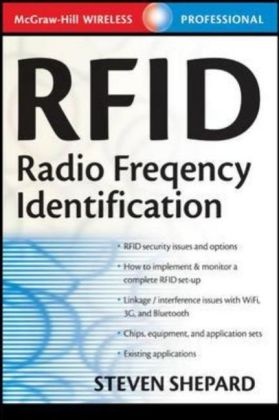Ulteriori informazioni
Informationen zum Autor Steven Shepard (Williston, VT) is a professional writer and educator specializing in international telecommunications. He has written and taught technical courses on a broad range of topics around the globe. He is the author of several books, including Telecommunications Convergence and Optical Networking Demystified. Klappentext Publisher's Note: Products purchased from Third Party sellers are not guaranteed by the publisher for quality, authenticity, or access to any online entitlements included with the product. TAG THE HOTTEST GROWTH IN WIRELESS With a predicted $10-billion market over the next decade, RFID (Radio Frequency Identification) is a booming new wireless technology with an eager new audience-retailers. From global giant Wal-Mart down, RFID is being adapted to track inventories via microchip-tagged products. Popular technology writer Steven Shepard's RFID gives you an inside look at the entire arena, from the technology's staggering capabilities and potential, through insightful coverage of issues from vendors, implementation, and monitoring, to possible technical conflicts, market forecasts, and security. A must-read for both technical types and retailers, this book's need-to-know contents include:Defining RFID . Underlying Technologies . Technological Competitors . Future RFID Applications . RFID/3G/Bluetooth Coexistence . Implementation . Potential Roadblocks . RFID Security . RFID Chips, Readers, and Applications Sets . Short- and Long-Term Forecasts Zusammenfassung RFID (Radio Frequency Identification) is a wireless technology adapted by retailers to track inventories via a microchip tagged product. This technology book on RFID explains the underlying wireless technologies! walks potential users and suppliers through the implementation and monitoring process! and deals in depth with security issues. Inhaltsverzeichnis PART ONE. BUSINESS ENABLERS Supply Chains: A Brief Overview The ServicePlus Story The History of Barcodes The 1790 Census From Census . . . to Groceries Tracking the Railroads Back to Groceries Barcodes . . . Up Close and Personal Encoding Details Digit Encoding in UPC A UPC Version E The Application Identifier Beyond Groceries Conclusion RFID History Pre-RFID: The Arrival of Radar First Deployments: Chain Home Radar Post-Radar Development Efforts The First RFID Tag: Mario Cardullo Later Developments In Summary PART TWO. RFID IN DETAIL Typical RFID System Components Transponders Passive vs. Active Transponders Operating Frequencies Frequency Attributes Form Factors Smart Cards Close-Coupling Smart Cards A Brief Aside: Inductive vs. Capacitive Coupling Proximity-Coupling Smart Cards Part 1: Physical Device Parameters Part 2: RF Characteristics Part 3: Initialization and Collision Control Manchester Encoding Transponder Selection Collision Management in Action The REQB Frame The ATQB Frame Slotted Aloha: How It Works The Air Interface: Data Communications Protocols Initiating Data Transmission Application Protocol Support Layer by Layer Layer Seven: The Application Layer Layer Six: The Presentation Layer Layer Five: The Session Layer Layer Four: The Transport Layer Layer Three: The Network Layer Layer Two: The Data Link Layer Layer One: The Physical Layer OSI Summary 107The OSI Model and the RFID Interface Vicinity-Coupling Smart Cards ISO 15693 Part One: Physical Device Characteristics ISO 15693 Part Two: RF Power, Data Transfer, and FrameStructures Data Transfer: Downstream, Reader to Card Data Transfer: Upstream, Card to Reader A Brief Aside: RFID Readers Enterprise Resource Planning (ERP) The ERP Process Summary RFID Security Considerations Key Security Considerations Privacy Concerns ...
Sommario
PART ONE. BUSINESS ENABLERS Supply Chains: A Brief Overview The ServicePlus Story The History of Barcodes The 1790 Census From Census . . . to Groceries Tracking the Railroads Back to Groceries Barcodes . . . Up Close and Personal Encoding Details Digit Encoding in UPC A UPC Version E The Application Identifier Beyond Groceries Conclusion RFID History Pre-RFID: The Arrival of Radar First Deployments: Chain Home Radar Post-Radar Development Efforts The First RFID Tag: Mario Cardullo Later Developments In Summary PART TWO. RFID IN DETAIL Typical RFID System Components Transponders Passive vs. Active Transponders Operating Frequencies Frequency Attributes Form Factors Smart Cards Close-Coupling Smart Cards A Brief Aside: Inductive vs. Capacitive Coupling Proximity-Coupling Smart Cards Part 1: Physical Device Parameters Part 2: RF Characteristics Part 3: Initialization and Collision Control Manchester Encoding Transponder Selection Collision Management in Action The REQB Frame The ATQB Frame Slotted Aloha: How It Works The Air Interface: Data Communications Protocols Initiating Data Transmission Application Protocol Support Layer by Layer Layer Seven: The Application Layer Layer Six: The Presentation Layer Layer Five: The Session Layer Layer Four: The Transport Layer Layer Three: The Network Layer Layer Two: The Data Link Layer Layer One: The Physical Layer OSI Summary 107The OSI Model and the RFID Interface Vicinity-Coupling Smart Cards ISO 15693 Part One: Physical Device Characteristics ISO 15693 Part Two: RF Power, Data Transfer, and FrameStructures Data Transfer: Downstream, Reader to Card Data Transfer: Upstream, Card to Reader A Brief Aside: RFID Readers Enterprise Resource Planning (ERP) The ERP Process Summary RFID Security Considerations Key Security Considerations Privacy Concerns

